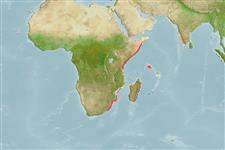Environment: milieu / climate zone / depth range / distribution range
Ecología
marino demersal; rango de profundidad 124 - 230 m (Ref. 10877). Tropical
Distribución
Países | Áreas FAO | Ecosistemas | Ocurrencias, apariciones | Point map | Introducciones | Faunafri
Western Indian Ocean: known only from 3 specimens from off Durban, South Africa and Kenya. Generic placement questionable, but possibly closely related to Tosarhombus octoculatus from Japan.
Tamaño / Peso / Age
Maturity: Lm ? range ? - ? cm
Max length : 18.0 cm TL macho / no sexado; (Ref. 4417)
Espinas dorsales (total): 0; Radios blandos dorsales (total): 79-89; Espinas anales 0; Radios blandos anales: 59 - 68. Eyed side brownish, pectoral fin with 10-12 rays; pectoral on blind side with 9-10 rays (Ref. 4417).
Life cycle and mating behavior
Madurez | Reproducción | Puesta | Huevos | Fecundidad | Larva
Amaoka, K. and J. Rivaton, 1991. Pisces Pleuronectiformes: A review of the genus Tosarhombus (Bothidae) with descriptions of two new species from Saya de Malha Bank (Indian Ocean) and the Chesterfield Islands (Coral Sea). p. 449-466. In A. Crosnier (ed.) Résultats des Campagnes MUSORSTOM, Volume 8. Mém. Mus. natn. Hist. nat., (A), 151:449-466. (Ref. 10877)
IUCN Red List Status (Ref. 130435)
Threat to humans
Harmless
Human uses
Más información
PaísesÁreas FAOEcosistemasOcurrencias, aparicionesIntroduccionesStocksEcologíaDietacomponentes alimenticiosconsumo de alimentoRación
Nombres comunesSinónimosMetabolismoDespredadoresEcotoxicologíaReproducciónMadurezPuestaAgregación para la puestaFecundidadHuevosEgg development
ReferenciasAcuiculturaPerfil de acuiculturaRazasGenéticaElectrophoresesheritabilidadEnfermedadesProcesamientoNutrientsMass conversion
Herramientas
Special reports
Download XML
Fuentes de Internet
Estimates based on models
Preferred temperature (Ref.
123201): 16.8 - 19, mean 17.9 °C (based on 13 cells).
Phylogenetic diversity index (Ref.
82804): PD
50 = 0.5156 [Uniqueness, from 0.5 = low to 2.0 = high].
Bayesian length-weight: a=0.00912 (0.00408 - 0.02036), b=3.05 (2.87 - 3.23), in cm total length, based on LWR estimates for this (Sub)family-body shape (Ref.
93245).
Nivel trófico (Ref.
69278): 3.6 ±0.4 se; based on size and trophs of closest relatives
Resiliencia (Ref.
120179): Medio, población duplicada en un tiempo mínimo de 1.4-4.4 años (Preliminary K or Fecundity.).
Fishing Vulnerability (Ref.
59153): Low vulnerability (10 of 100).
